Assessing the Impact of Water Efficiency Policies on Qatar’s Electricity and Water Sectors
Abstract
1. Introduction
- What are the future energy–water consumption patterns because of economic and population growth?
- How is efficiency in water and wastewater systems going to impact the consumption of energy?
- What options are present to secure reliable and long-term energy and water security in the region?
2. Background and Literature
2.1. Water Policies and Methods to Reduce Energy Consumption
2.2. Desalination, Wastewater Reuse and Groundwater Studies in the Region
2.3. Qatar’s Water Statistics (Production and Consumption Patterns)
3. Methodology
3.1. Causal Loop Diagram
3.2. Water Demand Estimation
- Qatar has seen its GDP growth rate stabilize between 2 and 5 percent recently, which is likely to stay between 2% and 3% in the near future [82]. Thus, in our estimation we have assumed that Qatar’s GDP growth rate after 2016 is likely to stabilize at 2.5%.
- The future precipitation estimate after 2016 were kept consistent at 76 mm/year, which is the average of rainfall between 1962–2017 [75].
- Wastewater treatment is at 17.2% for tertiary treated water and 82.8% for tertiary treatment with nitrogen and phosphorus removal.
- System losses limited to the desalinated water distribution network are consistent at 4%.
- The total groundwater abstracted is restricted to 250 million m3/year as can be seen in Figure 4 and past historical data as the resource is limited.
- The energy estimate for treated wastewater (collection and treatment) are only calculated for the amount that is being reused in different sectors and does not cover the entire collection and treatment cost of water that is pumped into aquifers, lagoons or the sea.
- Sc1: Water limitation policy implemented which enforces groundwater abstraction to only 50 million m3 maximum by the year 2025. The demand created because of this reduction in groundwater extraction is met through TSE or desalinated water or an equal combination of both. This policy implements the “Groundwater Aquifer Recharge” goal, the objective of which is to elevate the groundwater table to the 1980 levels. TSE-200 is the scenario where the entire supplemental demand is met through treated wastewater. DW200 is the scenario where the substitute water is entirely met through Qatar’s traditional desalinated water and DWTSE100 is the case where the groundwater is substituted equivalently through desalination and treated wastewater.
- Sc2: Reduction of water consumption by 10% in the household, industry and commercial sector separately and combined by 2050. The policy implements Qatar National Vision 2030’s environmental management and reduced energy consumption.
- Sc3: Gradual increase in share of RO-produced desalinated water to 50% of total desalinated water by 2050. This policy implements the objective of reducing desalination energy consumption, through alternate technologies such as RO.
4. Results and Discussion
Policy Suggestions
- To increase resiliency of the groundwater aquifers in Qatar, treated wastewater can be used. Because the underlying energy used in wastewater treatment is natural gas (through electricity produced from natural gas), total energy consumption and CO2 emissions rise by only 0.5% compared to BAU scenario in which groundwater is abstracted without restrictions.
- Move towards membrane technology as the type of desalination can reduce the energy burden by almost 3672 GWh.
- The increase in water-use efficiency of household, commercial and industrial sector and the consequent reduction in energy use and CO2 emissions mean that information and education campaigns are vital.
- The water loss through the water system went from very high to a low of 4%. However, careful consideration must be taken to further decrease the water losses, as the money injected into reducing losses are likely to have diminishing returns.
- Further improvements can be achieved through more efficient energy management, reduction of consumption, reduction of water losses, optimization of transportation and optimization of the entire water treatment process.
5. Conclusions and Future Work
- Because of data constraint a complete water balance model is difficult to establish. For example, the data do not show how much wastewater is generated from each sector of the economy or what type of treated wastewater (tertiary or tertiary with N and P removal) is reused in which sector. Furthermore, while the demand estimate using regression equation is accurate for the available data, long-term prediction may change (this has been somewhat resolved by running a sensitivity analysis shown in Figure A3 in Appendix A).
- As seen in the regression equations some of the variable coefficients are opposite to what we would have expected, such as the negative GDP. One reason for this is the relatively high multicollinearity in the dataset (Table A3), but it is important to note that the correlations are positive. Another likely cause of the erratic behavior is an omitted variable. However, due to the limited availability of data as well as the high validity of our system dynamics model, we argue that the regression equations are representative of a good prediction model.
- The energy consumption estimated is limited to the water that is being used. Energy consumed during collection and treatment of wastewater that is injected into aquifers, sea and lagoons is not incorporated in the total estimated consumption because of unavailable data.
- The energy costs of the techniques discussed are static over time.
- The system dynamic methodology does not incorporate the detailed engineering and energy design of various desalination technologies being used. Furthermore, statistical techniques have been used to compensate for the lack of dynamic interaction between components of the water system, such as the increase in water capacity of underwater aquifers because of rain and sea-water intrusion as well as the impact of water leakage throughout the system.
Author Contributions
Funding
Institutional Review Board Statement
Informed Consent Statement
Data Availability Statement
Conflicts of Interest
Appendix A
| Year | Agriculture (Million m3) | Household (Million m3) | Government (Million m3) | Commercial (Million m3) | Industry (Million m3) | Population (Million) | GDP (Billion USD) | Average Rainfall (mm) |
|---|---|---|---|---|---|---|---|---|
| 2006 | 257.69 | 141.1 | 18.39 | 24.6 | 8.3 | 1.010382 | 60.88214 | 84.9 |
| 2007 | 254.05 | 153.16 | 26.23 | 24.8 | 9.6 | 1.189633 | 79.71209 | 84.9 |
| 2008 | 248.15 | 189.29 | 38.77 | 26.2 | 8.78 | 1.389342 | 115.2701 | 42.9 |
| 2009 | 248.89 | 256.57 | 45.07 | 30.9 | 7.36 | 1.59078 | 97.79835 | 68.6 |
| 2010 | 261.16 | 279.39 | 62.33 | 27.9 | 7.76 | 1.779676 | 125.1223 | 33.1 |
| 2011 | 271.45 | 295.56 | 75.68 | 29.1 | 9.76 | 1.952054 | 167.7753 | 70.5 |
| 2012 | 288.76 | 308.68 | 64.42 | 65.2 | 10.2 | 2.109568 | 186.8335 | 23.9 |
| 2013 | 285.23 | 327.92 | 70.57 | 72.7 | 10.32 | 2.250473 | 198.7278 | 41.6 |
| 2014 | 294.92 | 347.59 | 80.85 | 74.97 | 10.48 | 2.374419 | 206.2247 | 52.4 |
| 2015 | 291.7 | 338.91 | 194.76 | 80.65 | 10.75 | 2.481539 | 161.7398 | 115.4 |
| 2016 | 296.29 | 342.05 | 112.55 | 132.25 | 11.62 | 2.569804 | 151.7321 | 101.1 |
| Element | Element Type | Expression | Units |
|---|---|---|---|
| Complete Water Supply Energy Consumption | Auxiliary | Total DIS En Cons + Total DW Energy + Total GW Energy + TSE Total Energy Cons | GWh |
| DISTRIBUTION Energy Factor | Auxiliary | 0.44 | GWh/M m3 |
| DW Supply Energy | Auxiliary | DISTRIBUTION Energy Factor × DW Volume | GWh |
| DWMED Energy Factor | Auxiliary | 19 | GWh/M m3 |
| DWMSF Energy Factor | Auxiliary | 20 | GWh/M m3 |
| DWSWRO Energy Factor | Auxiliary | 6 | GWh/M m3 |
| GW Energy Factor | Auxiliary | 0.36 | GWh/M m3 |
| GW Supply Energy | Auxiliary | DISTRIBUTION Energy Factor × GW Volume | GWh |
| MED En Cons | Auxiliary | DW Volume × MED Percentage × DWMED Energy Factor | GWh |
| MED Percentage | Auxiliary | 0.121 | Dmnl |
| MSF En Cons | Auxiliary | DW Volume × MSF Percentage × DWMSF Energy Factor | GWh |
| MSF Percentage | Auxiliary | 0.70 | Dmnl |
| SWRO En Cons | Auxiliary | DW Volume × SWRO Percentage × DWSWRO Energy Factor | GWh |
| SWRO Percentage | Auxiliary | 0.179 | Dmnl |
| Ter Energy Cons | Auxiliary | TSE Volume × Ter Percentage × Ter Energy Factor | GWh |
| Ter Energy Factor | Auxiliary | 0.44 | GWh/M m3 |
| Ter Percentage | Auxiliary | 0.172 | Dmnl |
| TerNP Energy Cons | Auxiliary | TSE Volume × TerNP Energy Factor × TerNP Percentage | GWh |
| TerNP Energy Factor | Auxiliary | 0.74 | GWh/M m3 |
| TerNP Percentage | Auxiliary | 0.828 | Dmnl |
| Total DIS En Cons | Auxiliary | Water Supplied × DISTRIBUTION Energy Factor | GWh |
| Total DW Energy | Auxiliary | MSF En Cons + MED En Cons + SWRO En Cons | GWh |
| Total GW Energy | Auxiliary | GW Volume × GW Energy Factor | GWh |
| TSE Supply Energy | Auxiliary | DISTRIBUTION Energy Factor × TSE Volume | GWh |
| TSE Total Energy Cons | Auxiliary | Ter Energy Cons + TerNP Energy Cons + WWC Energy | GWh |
| Water Demand | Auxiliary | GW Dem + TSE Dem + DW Dem | M m3/Year |
| Water Loss Energy Consumption | Auxiliary | (Water Loss Volume × DISTRIBUTION Energy Factor) + (Water Loss Volume × DWMSF Energy Factor × MSF Percentage) + (Water Loss Volume × DWMED Energy Factor × MED Percentage) + (Water Loss Volume × DWSWRO Energy Factor × SWRO Percentage) | GWh |
| Water Loss Percentage | Auxiliary | 0.04 | Dmnl |
| Water Supplied | Auxiliary | GW Volume + TSE Volume+DW Volume | M m3 |
| WWC Energy | Auxiliary | TSE Volume × WWC Factor | GWh |
| WWC Factor | Auxiliary | 0.04 | GWh/M m3 |
| DW Volume | Stock | 349.014 | M m3 |
| DW Dem | Flow | RegData. CMDW Dem + RegData. InDW Dem + RegData. HhDW Dem + RegData. GovDW Dem | M m3/Year |
| GWDW | Flow | 0.40 × GW Volume × Yr | M m3/Year |
| Water Loss | Flow | (Water Loss Percentage × DW Dem) + (Water Loss Percentage × GWDW) | M m3/Year |
| DW Supply | Flow | DW Volume × Yr | M m3/Year |
| GW Volume | Stock | 50.02 | M m3 |
| GW Dem | Flow | RegData. InGW Dem + RegData.AgGW Dem + RegData. HhGW Dem | M m3/Year |
| GW Supply | Flow | 0.2 × GW Volume × Yr | M m3/Year |
| GWDW | Flow | 0.40 × GW Volume × Yr | M m3/Year |
| GWTSE | Flow | 0.40 × GW Volume × Yr | M m3/Year |
| TSE Volume | Stock | 47.649 | M m3 |
| GWTSE | Flow | 0.40 × GW Volume × Yr | M m3/Year |
| TSE Dem | Flow | RegData. GovTSE Dem + RegData. AgTSE Dem | M m3/Year |
| TSE Supply | Flow | TSE Volume × Yr | M m3/Year |
| Water Loss Volume | Stock | 13.424 | M m3 |
| Exp Wat Loss | Flow | Water Loss | M m3/Year |
| Ac Water Loss | Flow | Water Loss Volume × Yr | M m3/Year |
| Sum DW Volume | Aggregate | Sum | M m3 |
| Sum GW Volume | Aggregate | Sum | M m3 |
| GDP | Auxiliary | GDPTb (Model. Time) | Dmnl |
| Million | Auxiliary | 1,000,000 | Million |
| Pop | Auxiliary | TotalPop (Model. Time)/Million | Dmnl |
| Rain | Auxiliary | Rainfall (Model. Time) | Dmnl |
| AgEqu | Flow | (203.3090 + 15.7276 × Pop + 0.2049 × GDP + 0.1646 × Rain) × Un | M m3/Year |
| CmEqu | Flow | (−55.89256 + 81.96694 × Pop − 0.34341 × GDP + 0.05626 × Rain) × Un | M m3/Year |
| GvEqu | Flow | (−103.39541 + 73.59845 × Pop − 0.04746 × GDP + 0.66357 × Rain) × Un | M m3/year |
| HhEqu | Flow | (30.57771 + 147.53605 × Pop − 0.07729 × GDP − 0.40296 × Rain) × Un | M m3/Year |
| InEqu | Flow | (4.63937 − 0.32591 × Pop + 0.02608 × GDP + 0.02805 × Rain) × Un | M m3/Year |
| AgGW Dem | Flow | 230 | M m3/Year |
| AgTSE Dem | Flow | AgEqu-AgGW Dem | M m3/Year |
| CMDW Dem | Flow | CmEqu | M m3/Year |
| GovDW Dem | Flow | GvEqu × 0.65 | M m3/Year |
| GovTSE Dem | Flow | GvEqu × 0.35 | M m3/Year |
| HhDW Dem | Flow | HhEqu-HhGW Dem | M m3/Year |
| HhGW Dem | Flow | 19.84 | M m3/Year |
| InDW Dem | Flow | InEqu-InGW Dem | M m3/Year |
| InGW Dem | Flow | 0.18 | M m3/Year |
| Final Time | Auxiliary | 40 | Year |
| Initial Time | Auxiliary | 0 | Year |
| Time Step | Auxiliary | 1 | Year |
| Co2 Emission Factor | Auxiliary | 486/1,000,000 | MtCO2/GWh |
| DW CO2 Emissions | Auxiliary | (Energy. DW Supply Energy + Energy. Total DW Energy) × Co2 Emission Factor | MtCO2 |
| GW CO2 Emissions | Auxiliary | (Energy. Total GW Energy + Energy. GW Supply Energy) × Co2 Emission Factor | MtCO2 |
| Total CO2 emissions | Auxiliary | Energy. Complete Water Supply Energy Consumption*Co2 Emission Factor | MtCO2 |
| TSE CO2 Emissions | Auxiliary | (Energy. TSE Total Energy Cons + Energy. TSE Supply Energy) × Co2 Emission Factor | MtCO2 |
| Water Loss CO2 emissions | Auxiliary | Energy. Water Loss Energy Consumption × Co2 Emission Factor | MtCO2 |
| Variables | Agriculture | Household | Government | Commercial | Industry | Population | GDP | Rainfall |
|---|---|---|---|---|---|---|---|---|
| Agriculture | 1.00 | 0.84 | 0.70 | 0.86 | 0.86 | 0.91 | 0.82 | 0.13 |
| Household | 0.84 | 1.00 | 0.72 | 0.73 | 0.60 | 0.97 | 0.88 | −0.05 |
| Government | 0.70 | 0.72 | 1.00 | 0.66 | 0.62 | 0.80 | 0.52 | 0.48 |
| Commercial | 0.86 | 0.73 | 0.66 | 1.00 | 0.83 | 0.85 | 0.59 | 0.30 |
| Industry | 0.86 | 0.60 | 0.62 | 0.83 | 1.00 | 0.75 | 0.66 | 0.31 |
| Population | 0.91 | 0.97 | 0.80 | 0.85 | 0.75 | 1.00 | 0.86 | 0.08 |
| GDP | 0.82 | 0.88 | 0.52 | 0.59 | 0.66 | 0.86 | 1.00 | −0.31 |
| Rainfall | 0.13 | −0.05 | 0.48 | 0.30 | 0.31 | 0.08 | −0.31 | 1.00 |
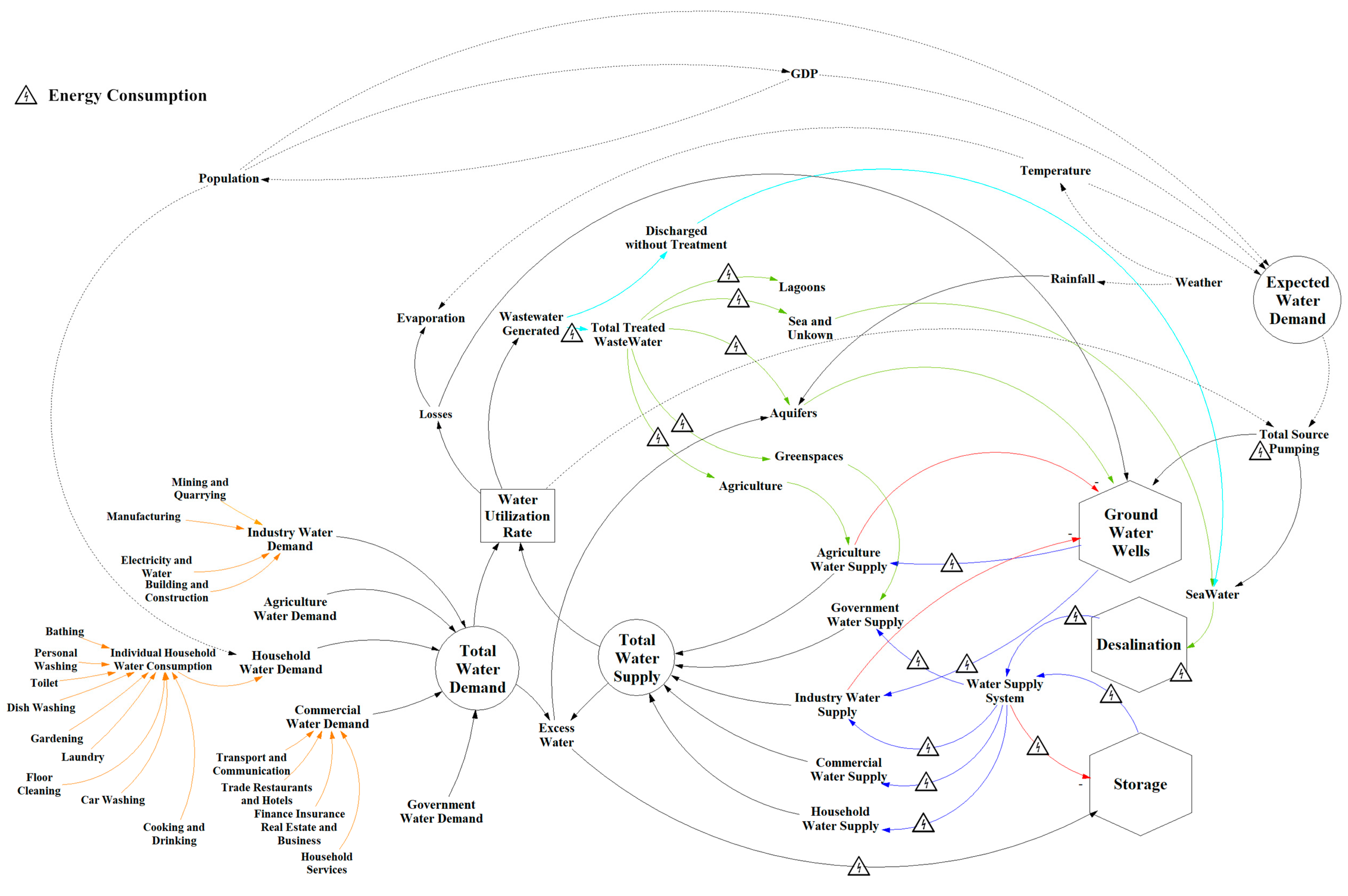
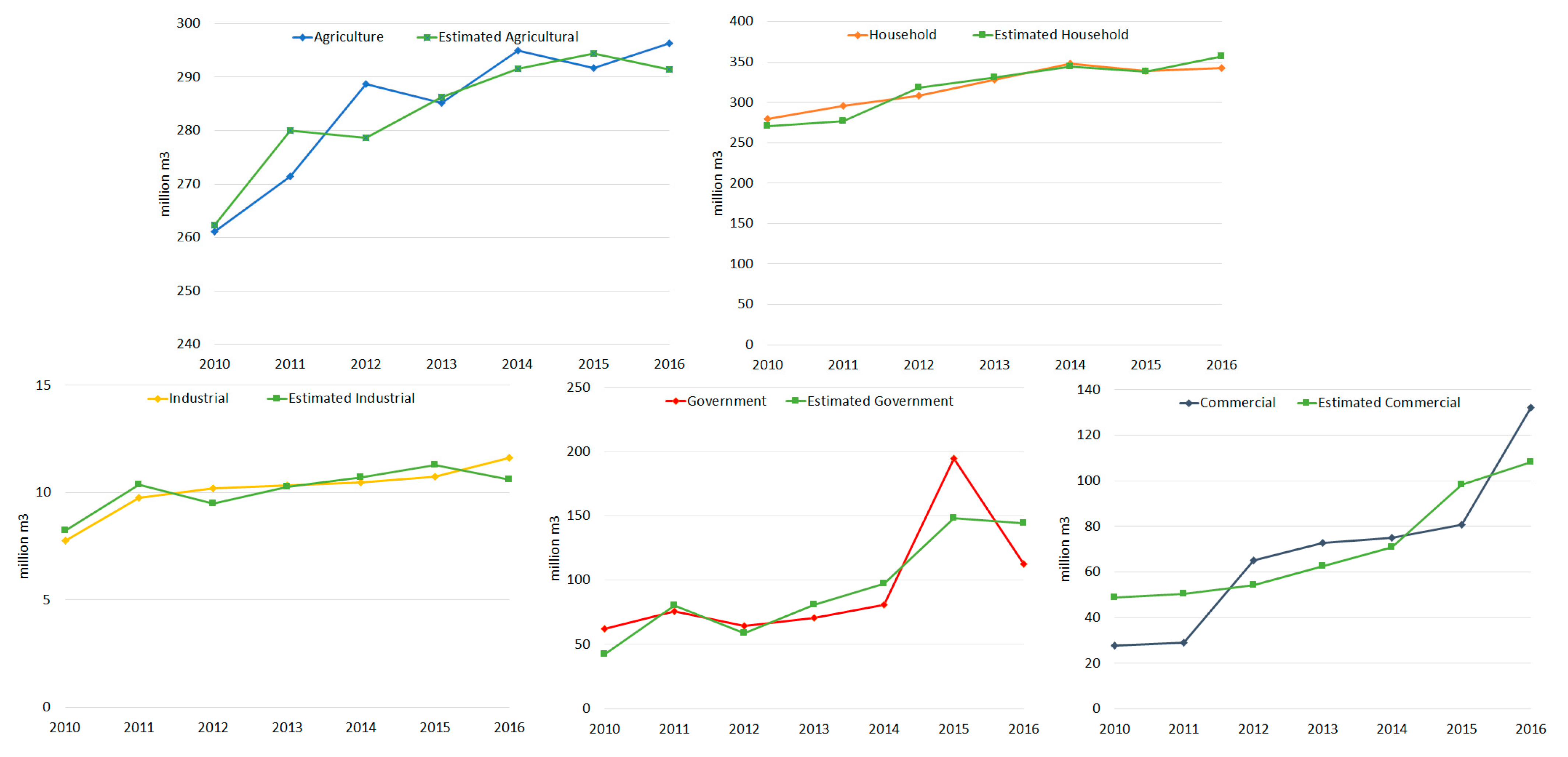
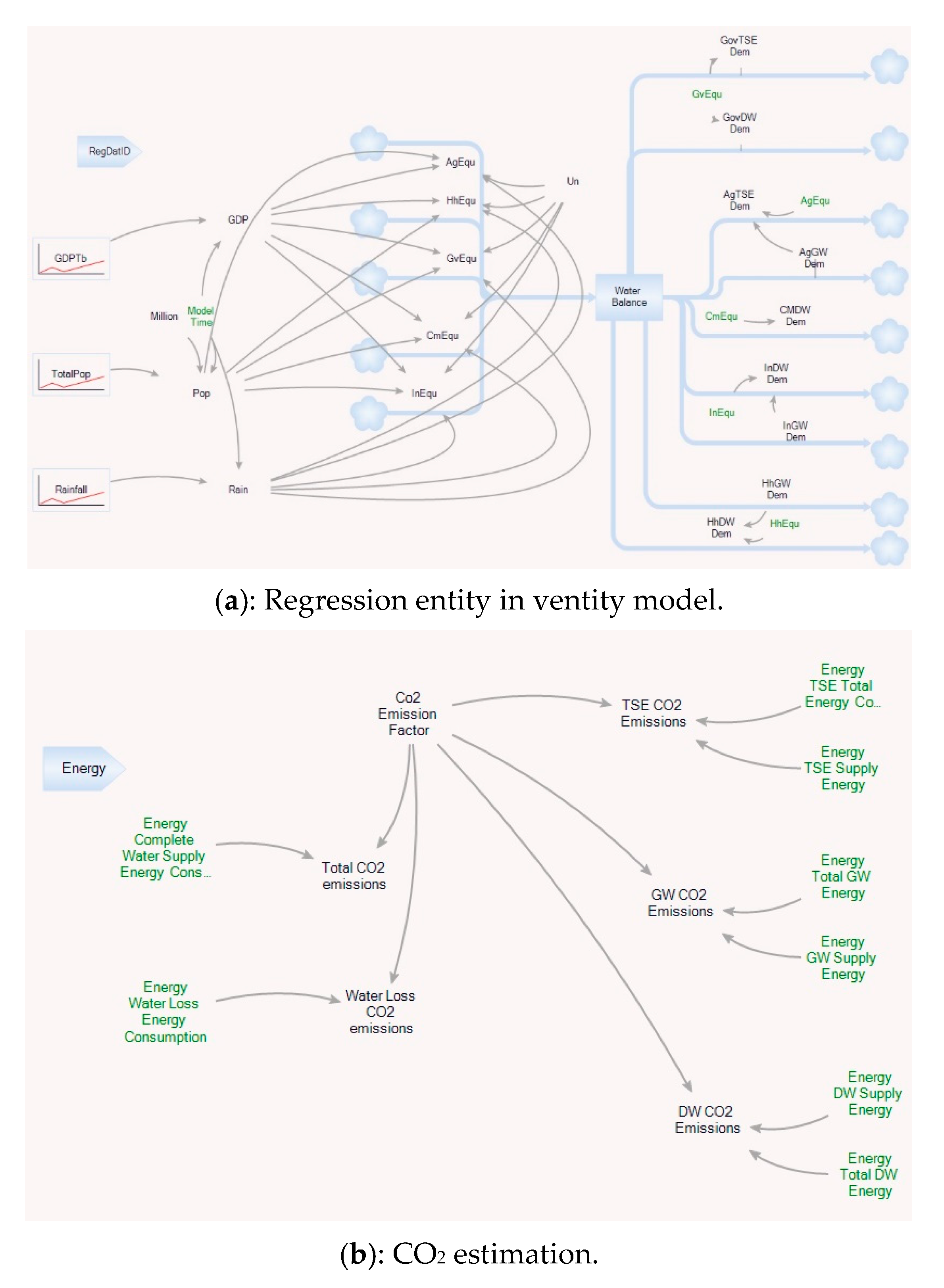
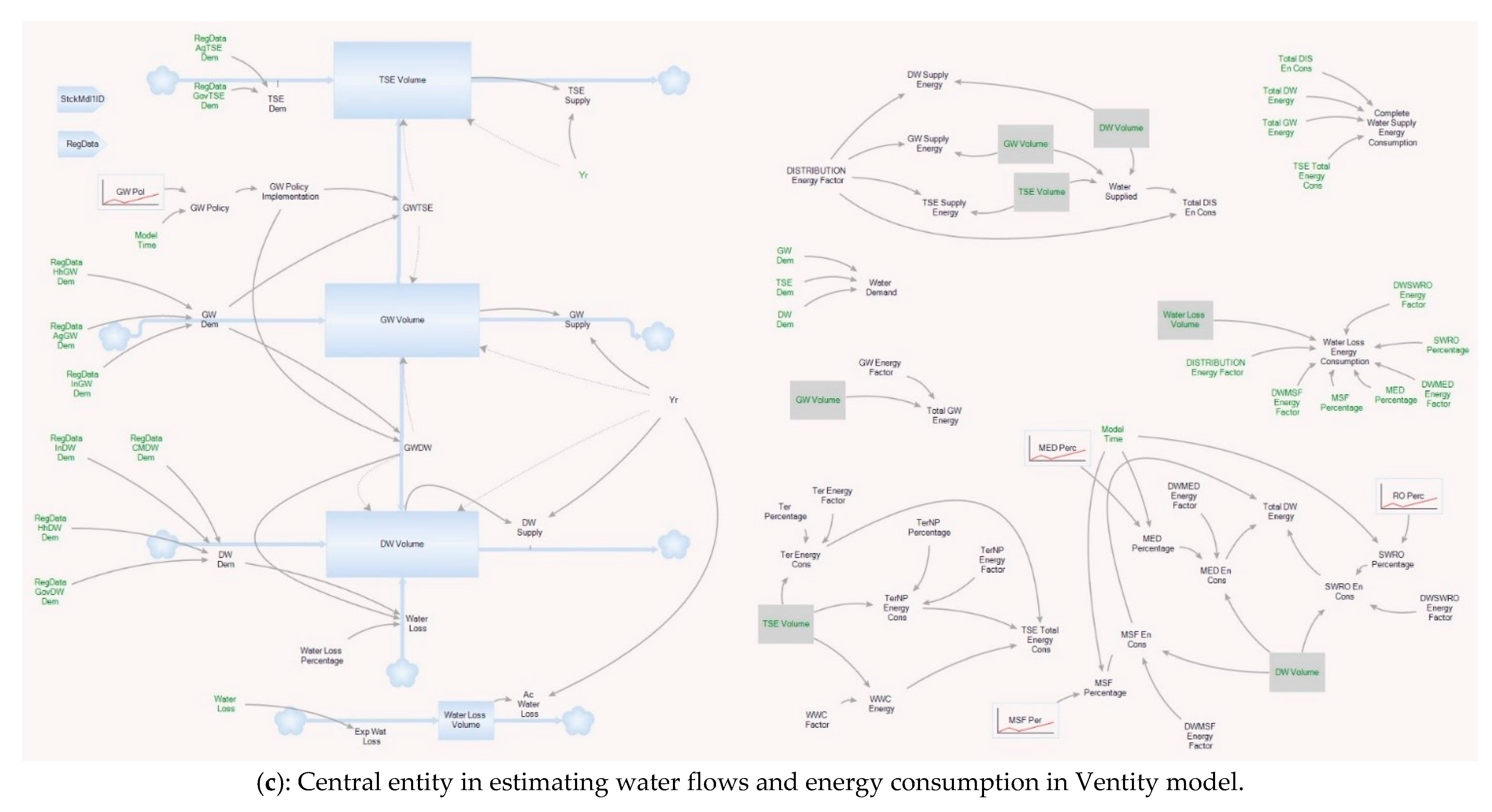

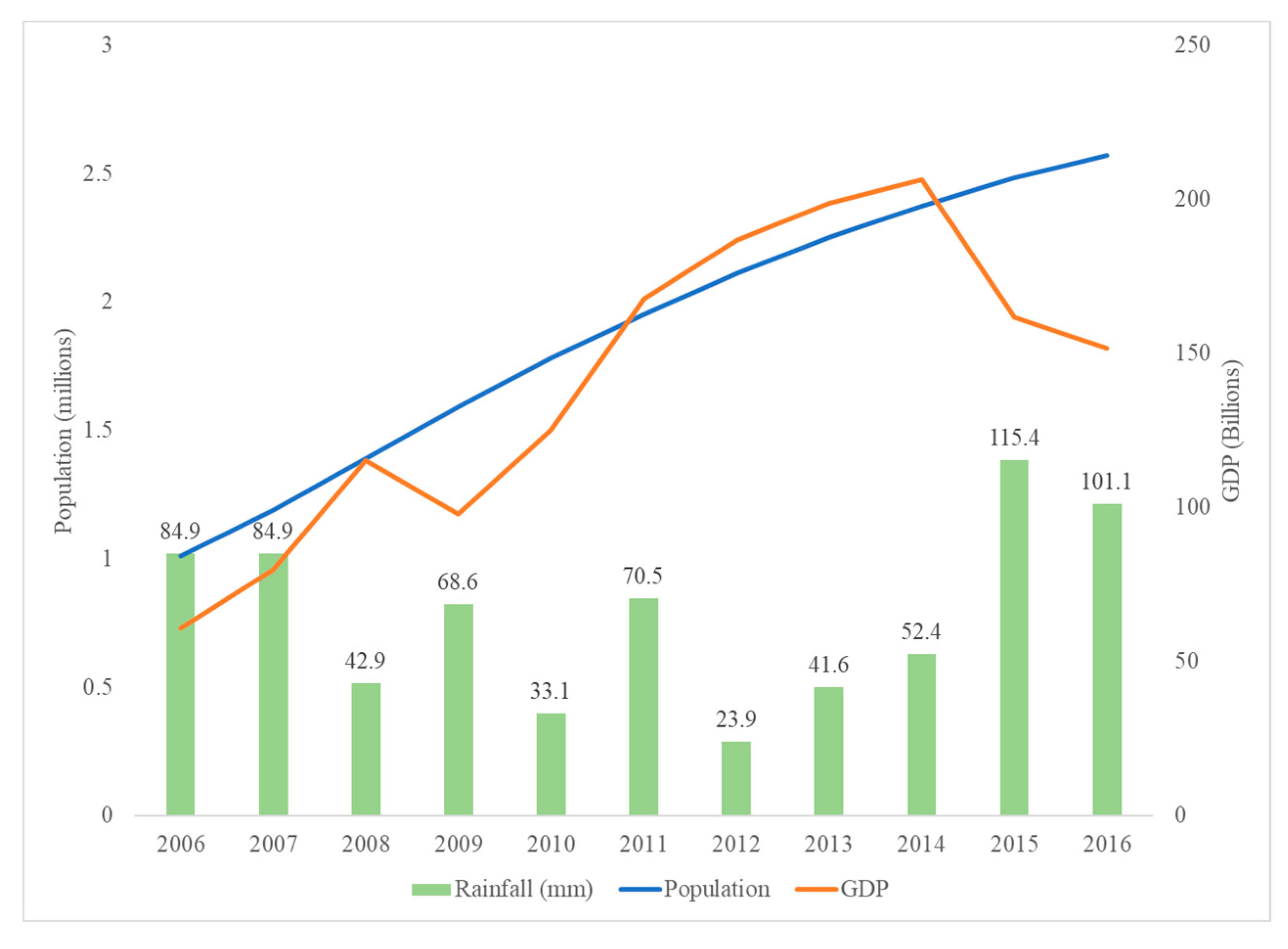
References
- Vairavamoorthy, K.; Gorantiwar, S.D.; Pathirana, A. Managing Urban Water Supplies in Developing Countries–Climate Change and Water Scarcity Scenarios. Phys. Chem. Earth Parts A/B/C 2008, 33, 330–339. [Google Scholar] [CrossRef]
- United Nations Global Issues-Water. Available online: https://www.un.org/en/sections/issues-depth/water/ (accessed on 23 February 2020).
- Wiek, A.; Larson, K.L. Water, People, and Sustainability—a Systems Framework for Analyzing and Assessing Water Governance Regimes. Water Resour. Manag. 2012, 26, 3153–3171. [Google Scholar] [CrossRef]
- Zarghami, S.A.; Gunawan, I.; Schultmann, F. Integrating Entropy Theory and Cospanning Tree Technique for Redundancy Analysis of Water Distribution Networks. Reliab. Eng. Syst. Saf. 2018, 176, 102–112. [Google Scholar] [CrossRef]
- De Oliveira, R.P.; Matos, J.S.; Monteiro, A.J. Managing the Urban Water Cycle in a Changing Environment. Water Util. J. 2015, 9, 3–12. [Google Scholar]
- Stokes, J.; Horvath, A. Life-Cycle Assessment of Urban Water Provision: Tool and Case Study in California. J. Infrastruct. Syst. 2011, 17, 15–24. [Google Scholar] [CrossRef]
- Chhipi-Shrestha, G.; Hewage, K.; Sadiq, R. Water–Energy–Carbon Nexus Modeling for Urban Water Systems: System Dynamics Approach. J. Water Resour. Plan. Manag. 2017, 143, 04017016. [Google Scholar] [CrossRef]
- Siddiqi, A.; Anadon, L.D. The Water–Energy Nexus in Middle East and North Africa. Energy Policy 2011, 39, 4529–4540. [Google Scholar] [CrossRef]
- Khalkhali, M.; Westphal, K.; Mo, W. The Water-Energy Nexus at Water Supply and Its Implications on the Integrated Water and Energy Management. Sci. Total Environ. 2018, 636, 1257–1267. [Google Scholar] [CrossRef]
- Li, Z.; Siddiqi, A.; Anadon, L.D.; Narayanamurti, V. Towards Sustainability in Water-Energy Nexus: Ocean Energy for Seawater Desalination. Renew. Sustain. Energy Rev. 2018, 82, 3833–3847. [Google Scholar] [CrossRef]
- IDA; GWI. IDA Water Security Handbook; 2019–2020. 2020. Available online: https://idadesal.org/e-library/ida-water-security-handbook/ (accessed on 10 June 2021).
- Richter, B.D.; Blount, M.E.; Bottorff, C.; Brooks, H.E.; Demmerle, A.; Gardner, B.L.; Herrmann, H.; Kremer, M.; Kuehn, T.J.; Kulow, E. Assessing the Sustainability of Urban Water Supply Systems. J. Am. Water Work. Assoc. 2018, 110, 40–47. [Google Scholar] [CrossRef]
- US EPA. Overview of Greenhouse Gases. Available online: https://www.epa.gov/ghgemissions/overview-greenhouse-gases (accessed on 24 June 2021).
- Hendrickson, T.P.; Horvath, A. A Perspective on Cost-Effectiveness of Greenhouse Gas Reduction Solutions in Water Distribution Systems. Environ. Res. Lett. 2014, 9, 024017. [Google Scholar] [CrossRef]
- Smith, K.; Liu, S.; Chang, T. Contribution of Urban Water Supply to Greenhouse Gas Emissions in China. J. Ind. Ecol. 2016, 20, 792–802. [Google Scholar] [CrossRef]
- Marlow, D.R.; Moglia, M.; Cook, S.; Beale, D.J. Towards Sustainable Urban Water Management: A Critical Reassessment. Water Res. 2013, 47, 7150–7161. [Google Scholar] [CrossRef]
- Nair, S.; Hashim, H.; Hannon, L.; Clifford, E. End Use Level Water and Energy Interactions: A Large Non-Residential Building Case Study. Water 2018, 10, 810. [Google Scholar] [CrossRef]
- Group, W.B. Beyond Scarcity: Water Security in the Middle East and North Africa; World Bank: Washington, DC, USA, 2018. [Google Scholar]
- Saif, O.; Mezher, T.; Arafat, H.A. Water Security in the GCC Countries: Challenges and Opportunities. J. Environ. Stud. Sci. 2014, 4, 329–346. [Google Scholar] [CrossRef]
- Al-Saidi, M.; Saliba, S. Water, Energy and Food Supply Security in the Gulf Cooperation Council (GCC) Countries—A Risk Perspective. Water 2019, 11, 455. [Google Scholar] [CrossRef]
- Raouf, M.A. Water Issues in the Gulf: Time for Action; Middle East Institute, ETH Zurich: Zürich, Switzerland, 2009. [Google Scholar]
- Atilhan, S.; Mahfouz, A.B.; Batchelor, B.; Linke, P.; Abdel-Wahab, A.; Nápoles-Rivera, F.; Jiménez-Gutiérrez, A.; El-Halwagi, M.M. A Systems-Integration Approach to the Optimization of Macroscopic Water Desalination and Distribution Networks: A General Framework Applied to Qatar’s Water Resources. Clean Technol. Environ. Policy 2012, 14, 161–171. [Google Scholar] [CrossRef]
- Von Medeazza, G.M. “Direct” and Socially-Induced Environmental Impacts of Desalination. Desalination 2005, 185, 57–70. [Google Scholar] [CrossRef]
- Dawoud, M.A. Environmental Impacts of Seawater Desalination: Arabian Gulf Case Study. Int. J. Environ. Sustain. 2012, 1, 22–37. [Google Scholar] [CrossRef]
- Missimer, T.M.; Maliva, R.G. Environmental Issues in Seawater Reverse Osmosis Desalination: Intakes and Outfalls. Desalination 2018, 434, 198–215. [Google Scholar] [CrossRef]
- IMF. World Economic Outlook (October 2019)—GDP per Capita, Current Prices. Available online: https://www.imf.org/external/datamapper/PPPPC@WEO/SAU/QAT/KWT/ARE/BHR (accessed on 27 February 2020).
- Winz, I.; Brierley, G.; Trowsdale, S. The Use of System Dynamics Simulation in Water Resources Management. Water Resour. Manag. 2009, 23, 1301–1323. [Google Scholar] [CrossRef]
- Duran-Encalada, J.A.; Paucar-Caceres, A.; Bandala, E.R.; Wright, G.H. The Impact of Global Climate Change on Water Quantity and Quality: A System Dynamics Approach to the US–Mexican Transborder Region. Eur. J. Oper. Res. 2017, 256, 567–581. [Google Scholar] [CrossRef]
- Sterman, J. Business Dynamics: Systems Thinking and Modeling for a Complex World; McGraw-Hill: New York, NY, USA, 2000; Available online: https://www.researchgate.net/publication/44827001_Business_Dynamics_System_Thinking_and_Modeling_for_a_Complex_World (accessed on 10 June 2021).
- Duggan, J. An introduction to system dynamics. In System Dynamics Modeling with R; Springer: Berlin/Heidelberg, Germany, 2016; pp. 1–24. Available online: https://www.researchgate.net/publication/303972873_An_Introduction_to_System_Dynamics (accessed on 12 June 2021).
- Dolado, J.J. Qualitative Simulation and System Dynamics. Syst. Dyn. Rev. 1992, 8, 55–81. [Google Scholar] [CrossRef]
- Zarghami, M.; Akbariyeh, S. System Dynamics Modeling for Complex Urban Water Systems: Application to the City of Tabriz, Iran. Resour. Conserv. Recycl. 2012, 60, 99–106. [Google Scholar] [CrossRef]
- Sharawat, I.; Dahiya, R.; Dahiya, R.P.; Sreekrishnan, T.R.; Kumari, S. Policy Options for Managing the Water Resources in Rapidly Expanding Cities: A System Dynamics Approach. Sustain. Water Resour. Manag. 2019, 5, 1201–1215. [Google Scholar] [CrossRef]
- Chen, C.; Ahmad, S.; Kalra, A.; Xu, Z. A Dynamic Model for Exploring Water-Resource Management Scenarios in an Inland Arid Area: Shanshan County, Northwestern China. J. Mt. Sci. 2017, 14, 1039–1057. [Google Scholar] [CrossRef]
- Chang, Y.-T.; Liu, H.-L.; Bao, A.-M.; Chen, X.; Wang, L. Evaluation of Urban Water Resource Security under Urban Expansion Using a System Dynamics Model. Water Sci. Technol. Water Supply 2015, 15, 1259–1274. [Google Scholar] [CrossRef]
- Sun, Y.; Liu, N.; Shang, J.; Zhang, J. Sustainable Utilization of Water Resources in China: A System Dynamics Model. J. Clean. Prod. 2017, 142, 613–625. [Google Scholar] [CrossRef]
- Alvi, M.S.Q.; Mahmood, I.; Javed, F.; Malik, A.W.; Sarjoughian, H. Dynamic Behavioural Modeling, Simulation and Analysis of Household Water Consumption in an Urban Area: A Hybrid Approach. In Proceedings of the 2018 Winter Simulation Conference (WSC), Gothenburg, Sweden, 9 December 2018; pp. 2411–2422. [Google Scholar]
- Chen, Z.; Wei, S. Application of System Dynamics to Water Security Research. Water Resour. Manag. 2014, 28, 287–300. [Google Scholar] [CrossRef]
- Zarghami, S.A.; Gunawan, I.; Schultmann, F. System Dynamics Modelling Process in Water Sector: A Review of Research Literature. Syst. Res. Behav. Sci. 2018, 35, 776–790. [Google Scholar] [CrossRef]
- Raj, K. Sustainable Urban Habitats and Urban Water Supply: Accounting for Unaccounted for Water in Bangalore City, India. Curr. Urban Stud. 2013, 1, 156. [Google Scholar] [CrossRef][Green Version]
- Topi, C.; Esposto, E.; Govigli, V.M. The Economics of Green Transition Strategies for Cities: Can Low Carbon, Energy Efficient Development Approaches Be Adapted to Demand Side Urban Water Efficiency? Environ. Sci. Policy 2016, 58, 74–82. [Google Scholar] [CrossRef]
- WWAP. The United Nations World Water Development Report 2017. Wastewater: The Untapped Resource; UNESCO: Paris, France, 2017. [Google Scholar]
- Lafforgue, M.; Lenouvel, V. Closing the Urban Water Loop: Lessons from Singapore and Windhoek. Environ. Sci. Water Res. Technol. 2015, 1, 622–631. [Google Scholar] [CrossRef]
- Leigh, N.G.; Lee, H. Sustainable and Resilient Urban Water Systems: The Role of Decentralization and Planning. Sustainability 2019, 11, 918. [Google Scholar] [CrossRef]
- Sapkota, M.; Arora, M.; Malano, H.; Moglia, M.; Sharma, A.; George, B.; Pamminger, F. An Overview of Hybrid Water Supply Systems in the Context of Urban Water Management: Challenges and Opportunities. Water 2015, 7, 153–174. [Google Scholar] [CrossRef]
- Younos, T. Paradigm Shift: Holistic Approach for Water Management in Urban Environments. Front. Earth Sci. 2011, 5, 421–427. [Google Scholar] [CrossRef]
- Cohen, R.; Nelson, B.; Wolff, G. Energy down the Drain: The Hidden Costs of California’s Water Supply; Natural Resources Defense Council, Pacific Institute: Oakland, CA, USA, 2004. [Google Scholar]
- Kumar, G.; Karney, B.W. Electricity Usage in Water Distribution Networks. In Proceedings of the 2007 IEEE Canada Electrical Power Conference, Montreal, QC, Canada, 25–26 October 2007; pp. 97–102. [Google Scholar]
- Tortajada, C.; Joshi, Y.K.; Biswas, A.K. The Singapore Water Story: Sustainable Development in an Urban City State; Routledge: London, UK, 2013; ISBN 1-135-12590-2. [Google Scholar]
- Ibrahim, A.-J. Energy-Water-Environment Nexus and the Transition Towards a Circular Economy: The Case of Qatar. 16. Available online: https://link.springer.com/article/10.1007/s43615-021-00037-w (accessed on 12 June 2021).
- Tahir, F.; Baloch, A.A.; Ali, H. Resilience of Desalination Plants for Sustainable Water Supply in Middle East. In Sustainability Perspectives: Science, Policy and Practice; Springer: Berlin/Heidelberg, Germany, 2020; pp. 303–329. [Google Scholar]
- Darwish, M.A.; Mohtar, R. Qatar Water Challenges. Desalin. Water Treat. 2013, 51, 75–86. [Google Scholar] [CrossRef]
- Ahmad, A.Y.; Al-Ghouti, M.A. Approaches to Achieve Sustainable Use and Management of Groundwater Resources in Qatar: A Review. Groundw. Sustain. Dev. 2020, 11, 100367. [Google Scholar] [CrossRef]
- Mannan, M.; Alhaj, M.; Mabrouk, A.N.; Al-Ghamdi, S.G. Examining the Life-Cycle Environmental Impacts of Desalination: A Case Study in the State of Qatar. Desalination 2019, 452, 238–246. [Google Scholar] [CrossRef]
- Jasim, S.Y.; Saththasivam, J.; Loganathan, K.; Ogunbiyi, O.O.; Sarp, S. Reuse of Treated Sewage Effluent (TSE) in Qatar. J. Water Process Eng. 2016, 11, 174–182. [Google Scholar] [CrossRef]
- Lambert, L.A.; Lee, J. Nudging Greywater Acceptability in a Muslim Country: Comparisons of Different Greywater Reuse Framings in Qatar. Environ. Sci. Policy 2018, 89, 93–99. [Google Scholar] [CrossRef]
- Alsheyab, M.A.T.; Kusch-Brandt, S. Potential Recovery Assessment of the Embodied Resources in Qatar’s Wastewater. Sustainability 2018, 10, 3055. [Google Scholar] [CrossRef]
- Ahmad, A.Y.; Al-Ghouti, M.A.; Khraisheh, M.; Zouari, N. Hydrogeochemical Characterization and Quality Evaluation of Groundwater Suitability for Domestic and Agricultural Uses in the State of Qatar. Groundw. Sustain. Dev. 2020, 11, 100467. [Google Scholar] [CrossRef]
- Qatar, G. Qatar National Vision 2030. Doha Gen. Secr. Dev. 2008. Available online: https://www.gco.gov.qa/en/about-qatar/national-vision2030/ (accessed on 15 June 2021).
- QNRS. Qatar National Research Strategy 2014. 2014. Available online: https://www.qnrf.org/en-us/About-Us/QNRS (accessed on 17 June 2021).
- Darwish, M.A.; Abdulrahim, H.K.; Mohieldeen, Y. Qatar and GCC Water Security. Desalin. Water Treat. 2015, 55, 2302–2325. [Google Scholar] [CrossRef]
- PSA. Qatar in Figures; Planning and Statistics Authority: Doha, Qatar, 2019.
- PSA. Water Statistics in the State of Qatar 2015; Planning and Statistics Authority: Doha, Qatar, 2017.
- Baalousha, H.M. Development of a Groundwater Flow Model for the Highly Parameterized Qatar Aquifers. Model. Earth Syst. Environ. 2016, 2, 67. [Google Scholar] [CrossRef]
- Shomar, B.; Darwish, M.; Rowell, C. What Does Integrated Water Resources Management from Local to Global Perspective Mean? Qatar as a Case Study, the Very Rich Country with No Water. Water Resour. Manag. 2014, 28, 2781–2791. [Google Scholar] [CrossRef]
- FAO. FAO’s Information System on Water and Agriculture-Qatar. Available online: http://www.fao.org/nr/water/aquastat/countries_regions/QAT/ (accessed on 15 October 2019).
- KAHRAMAA. KAHRAMAA Statistics Report 2017; 2017; p. 73. Available online: https://www.psa.gov.qa/en/statistics/Statistical%20Releases/Environmental/Water/2017/Water-Statistics-2017-EN.pdf (accessed on 10 June 2021).
- Mezher, T.; Fath, H.; Abbas, Z.; Khaled, A. Techno-Economic Assessment and Environmental Impacts of Desalination Technologies. Desalination 2011, 266, 263–273. [Google Scholar] [CrossRef]
- QGBC. Reclamation and Reuse Infrastructure. Available online: https://qatargbc.org/education/articles/a0003 (accessed on 16 March 2020).
- Ghaffour, N.; Missimer, T.M.; Amy, G.L. Combined Desalination, Water Reuse, and Aquifer Storage and Recovery to Meet Water Supply Demands in the GCC/MENA Region. Desalin. Water Treat. 2013, 51, 38–43. [Google Scholar] [CrossRef]
- KAHRAMAA. KAHRAMAA—Water Security Mega Reservoirs Project. Available online: http://www.watermegareservoirs.qa/ (accessed on 16 March 2020).
- KAHRAMAA. Qatar General Electricity & Water Corporation. Available online: https://www.km.com.qa/AboutUs/Pages/WaterSector.aspx (accessed on 7 March 2020).
- Darwish, M.A.; Abdulrahim, H.; Mohammed, S.; Mohtar, R. The Role of Energy to Solve Water Scarcity in Qatar. Desalin. Water Treat. 2016, 57, 18639–18667. [Google Scholar] [CrossRef]
- PSA. Water Statistics in the State of Qatar 2017; Planning and Statistics Authority: Doha, Qatar, 2018.
- PSA. Environment Statistics Report in the State of Qatar 2017; Planning and Statistics Authority: Doha, Qatar, 2019.
- World Bank. Arable Land (% of Land Area)—Qatar|Data. Available online: https://data.worldbank.org/indicator/AG.LND.ARBL.ZS?locations=QA (accessed on 1 March 2020).
- World Bank. Agriculture, Forestry, and Fishing, Value Added (% of GDP)—Qatar|Data. Available online: https://data.worldbank.org/indicator/NV.AGR.TOTL.ZS?locations=QA (accessed on 1 March 2020).
- Ventana Systems, Inc. Vensim PLE; Ventana Systems, Inc.: Harvard, MA, USA, 2010. [Google Scholar]
- Ventana Systems, Inc. Ventity—Simulation Software for Complex Systems; Ventana Systems, Inc.: Harvard, MA, USA, 2018. [Google Scholar]
- Gleick, P.H. Water in Crisis: Paths to Sustainable Water Use. Ecol. Appl. 1998, 8, 571–579. [Google Scholar] [CrossRef]
- Xiao-jun, W.; Jian-yun, Z.; Shahid, S.; ElMahdi, A.; Rui-min, H.; Zhen-xin, B.; Ali, M. Water Resources Management Strategy for Adaptation to Droughts in China. Mitig. Adapt. Strateg. Glob. Chang. 2012, 17, 923–937. [Google Scholar] [CrossRef]
- IMF. World Economic Outlook (October 2019)—Real GDP Growth. Available online: https://www.imf.org/external/datamapper/NGDP_RPCH@WEO/QAT (accessed on 13 March 2020).
- Kamal, A.; Al-Ghamdi, S.G.; Koç, M. Modeling and Understanding the Impacts of Efficiency Measures on Fleet Fuel Consumption in Vehicle Importing Countries: A Case Study of Qatar. J. Clean. Prod. 2020, 120619. [Google Scholar] [CrossRef]
- Kamal, A.; Al-Ghamdi, S.G.; Koç, M. Role of Energy Efficiency Policies on Energy Consumption and CO2 Emissions for Building Stock in Qatar. J. Clean. Prod. 2019, 235, 1409–1424. [Google Scholar] [CrossRef]
- QEWC Kahramaa, Umm Al Houl Power in Deal to Boost Water Desalination Capacity|Qatar Electricity & Water Co. Available online: https://www.qewc.com/qewc/en/kahramaa-umm-al-houl-power-in-deal-to-boost-water-desalination-capacity/ (accessed on 21 March 2020).
- Alhaj, M.; Mabrouk, A.; Al-Ghamdi, S.G. Energy Efficient Multi-Effect Distillation Powered by a Solar Linear Fresnel Collector. Energy Convers. Manag. 2018, 171, 576–586. [Google Scholar] [CrossRef]
- IEA. CO2 Emissions from Fuel Combustion: 2017; IEA: Paris, France, 2017. [Google Scholar]
- World Bank Population, Total|Data. Available online: https://data.worldbank.org/indicator/SP.POP.TOTL?locations=QA (accessed on 7 October 2018).
- IMF. World Economic Outlook (October 2019)—GDP, Current Prices. Available online: https://www.imf.org/external/datamapper/NGDPD@WEO/QAT (accessed on 13 March 2020).
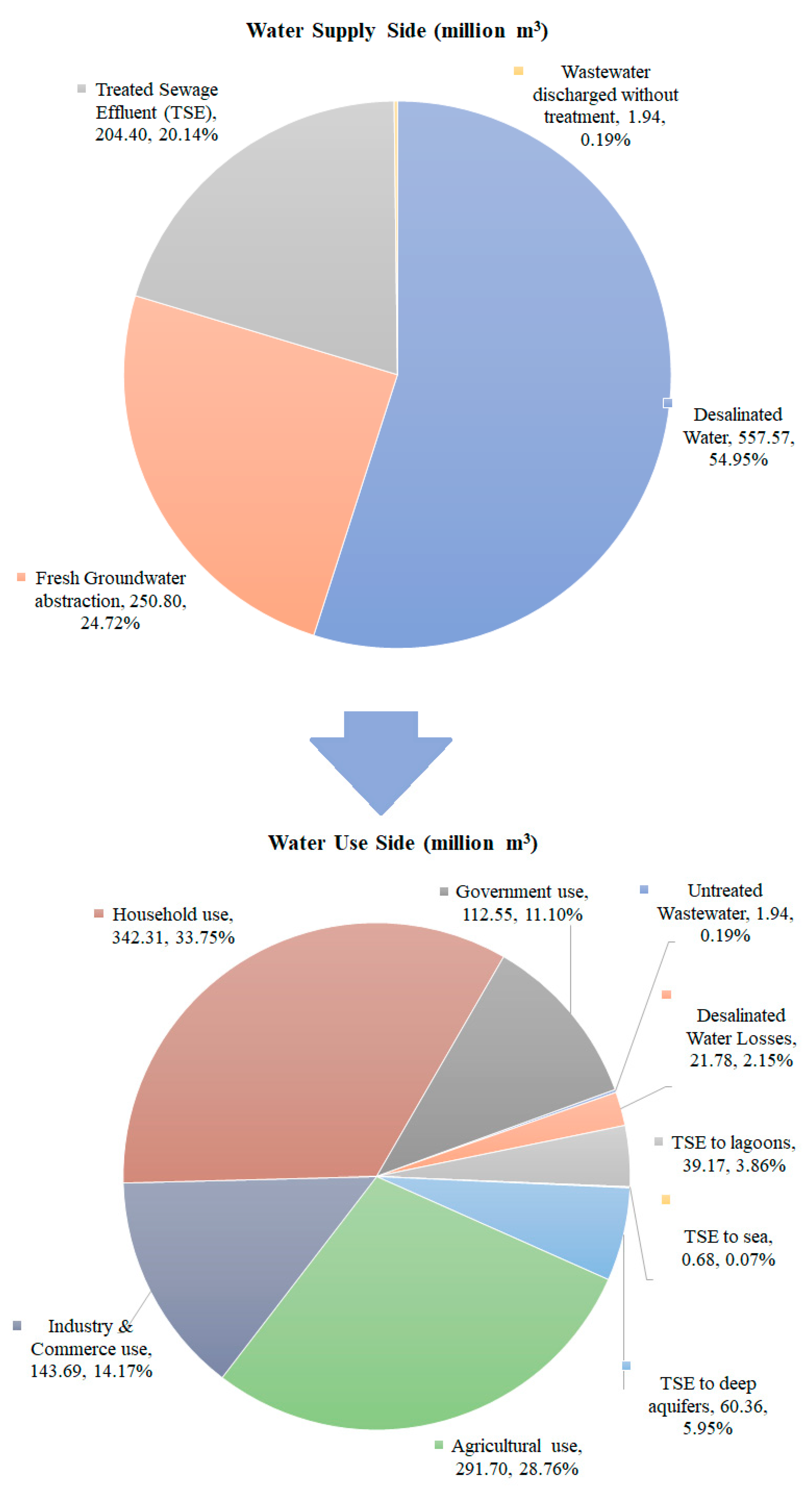
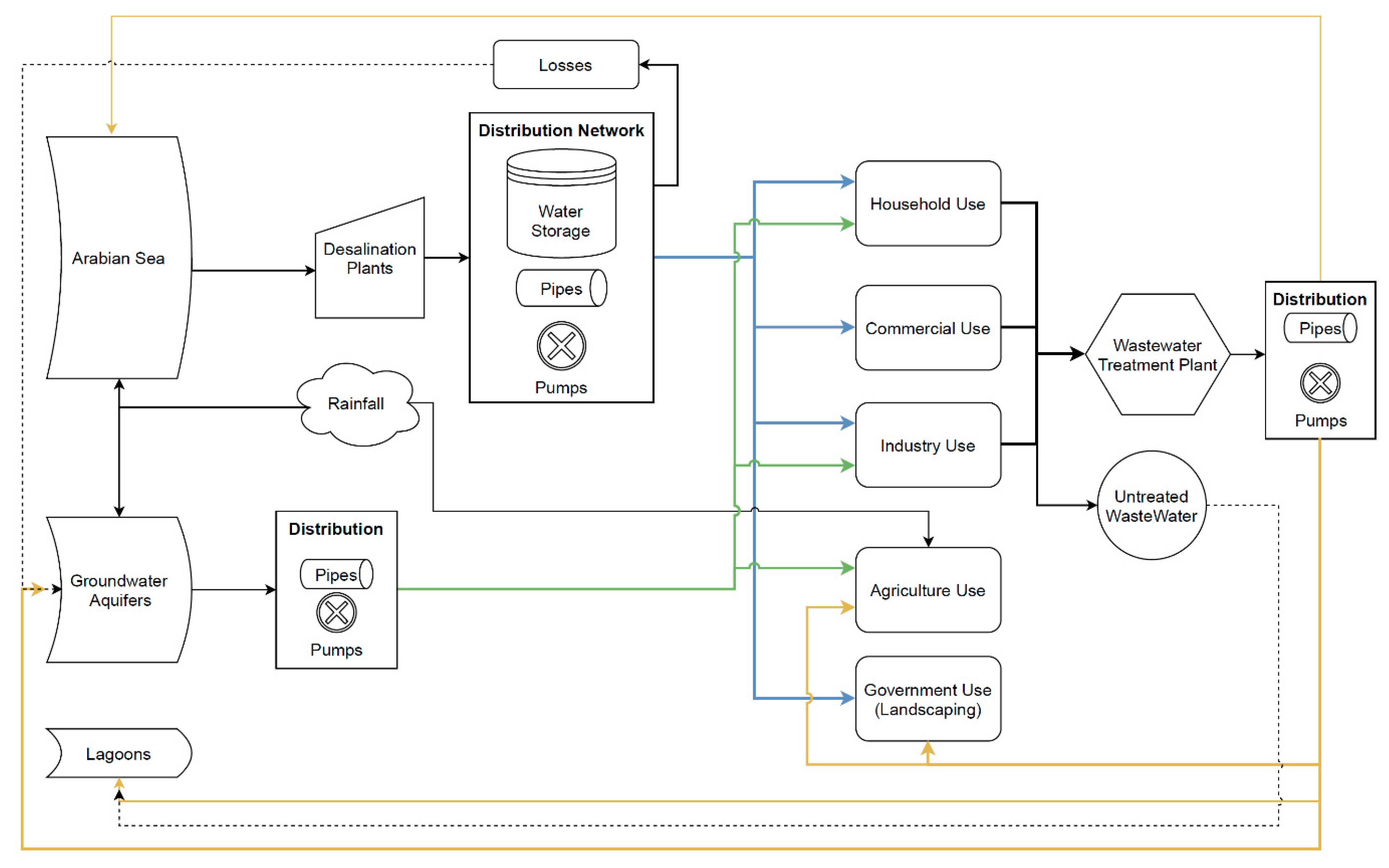

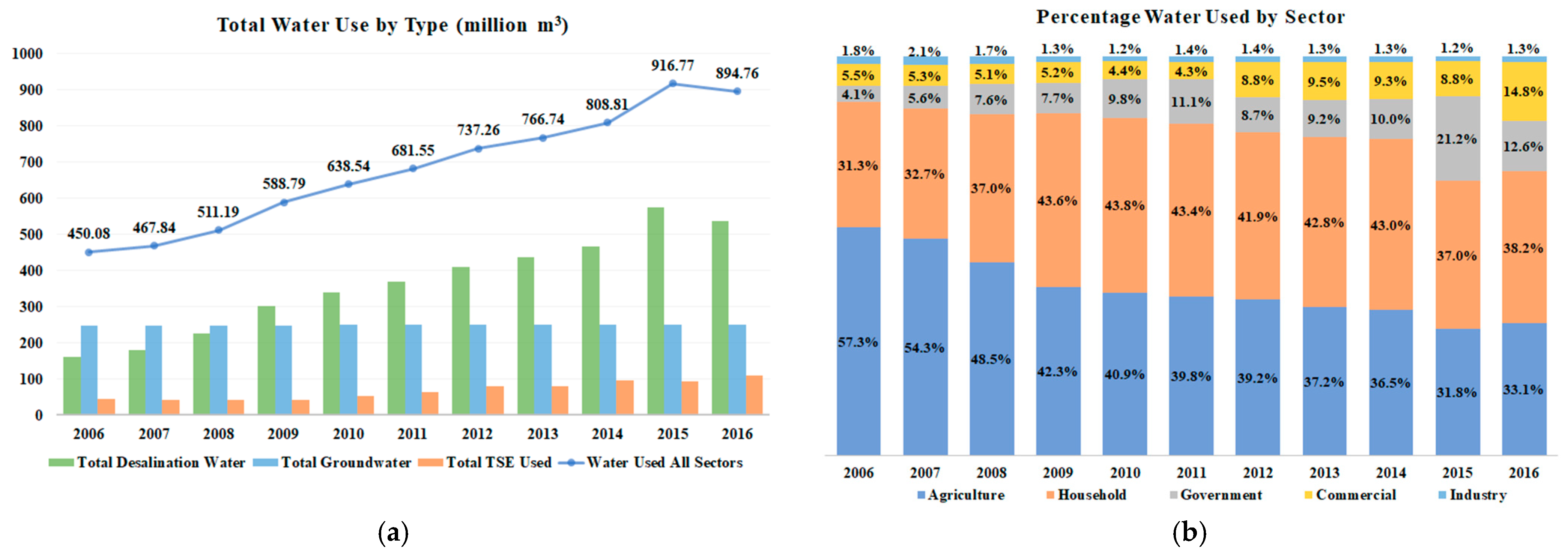
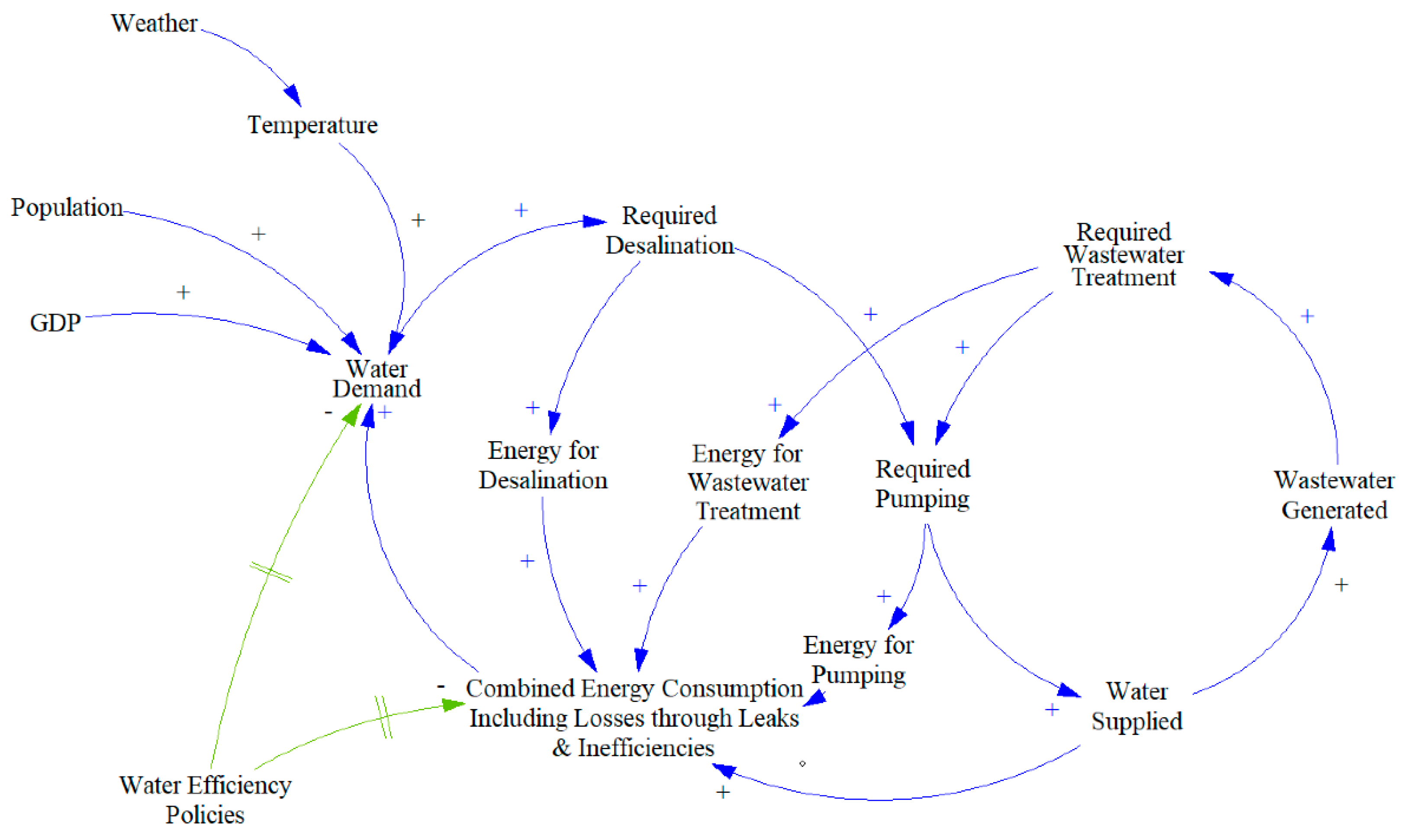

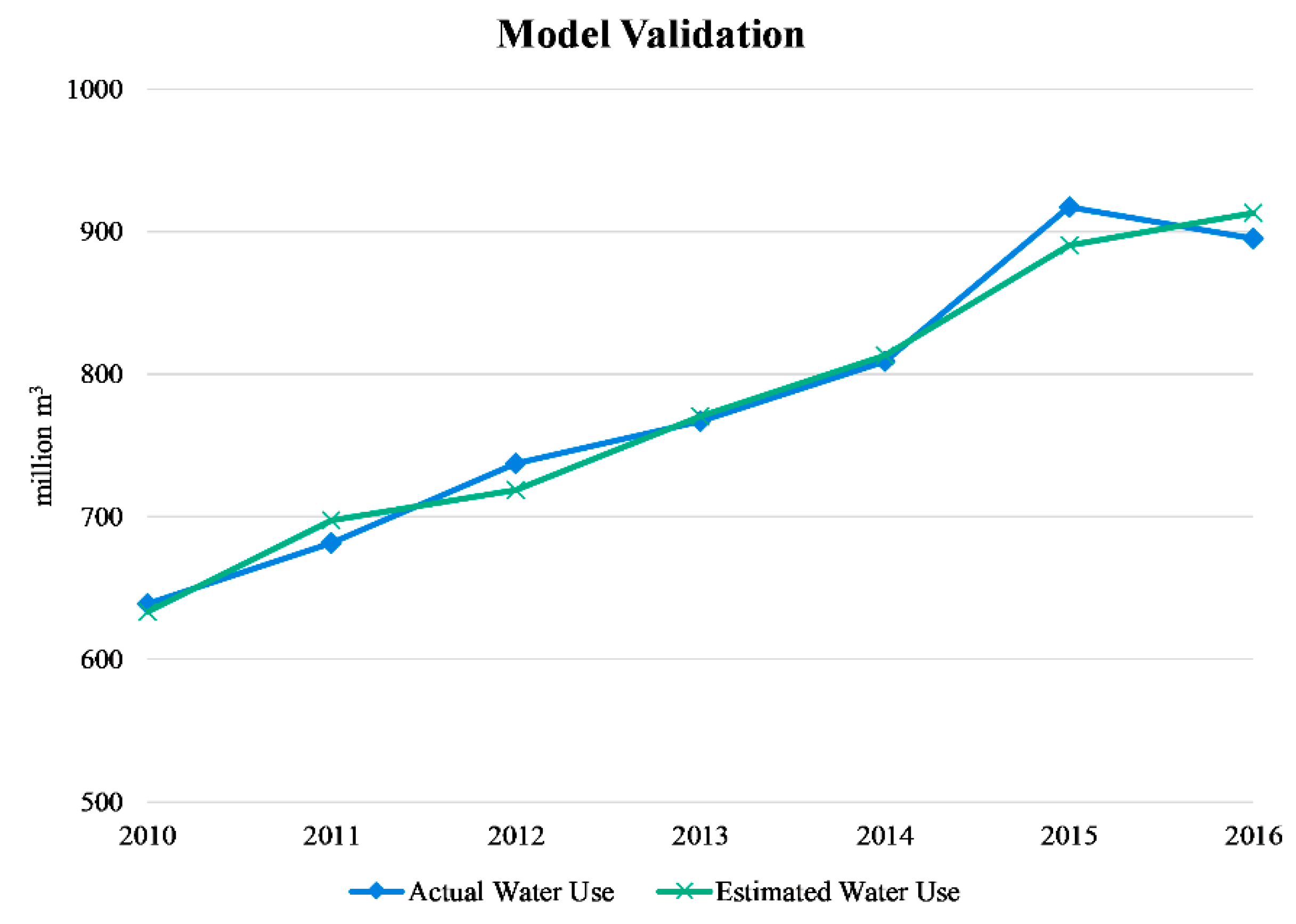
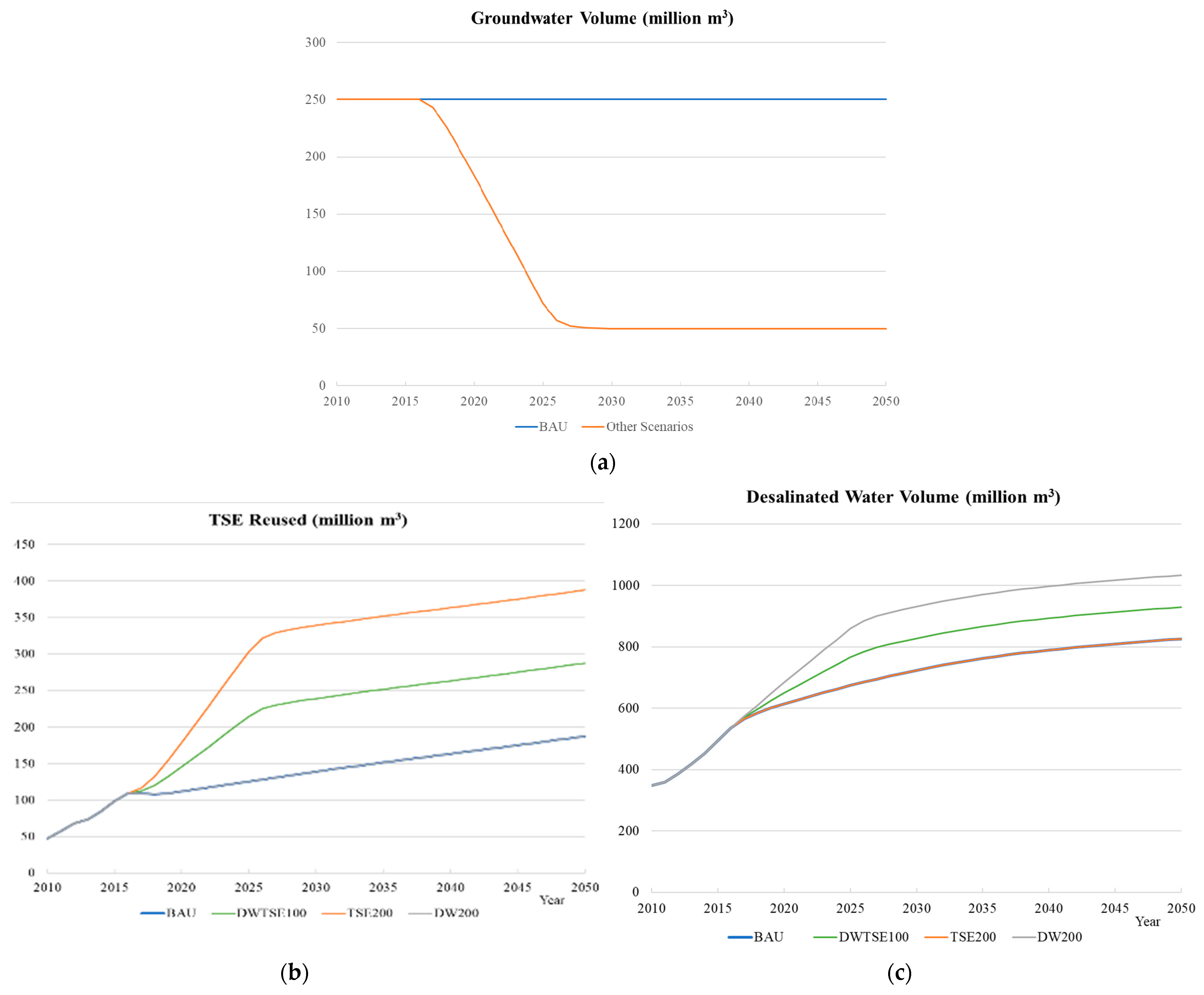
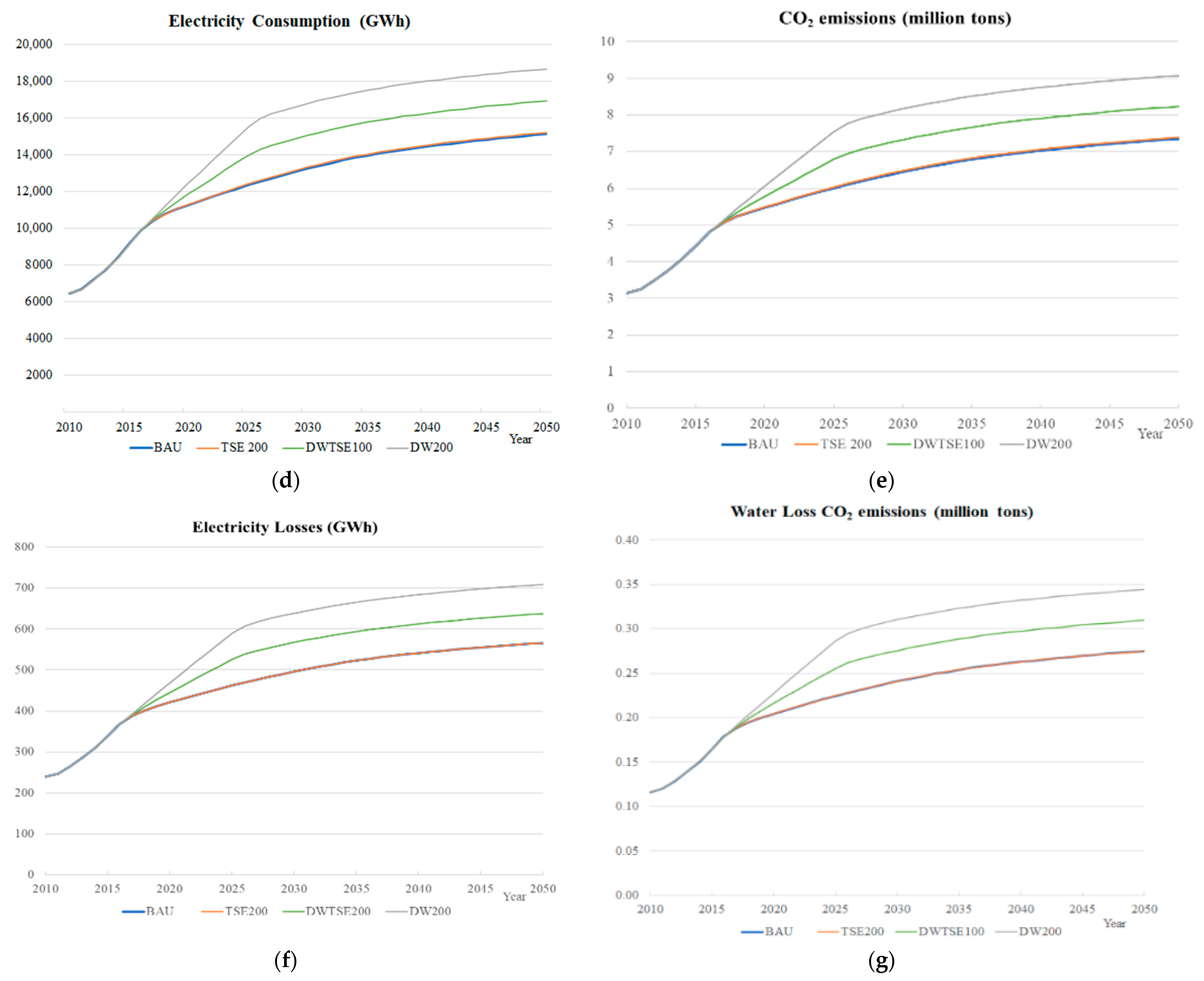


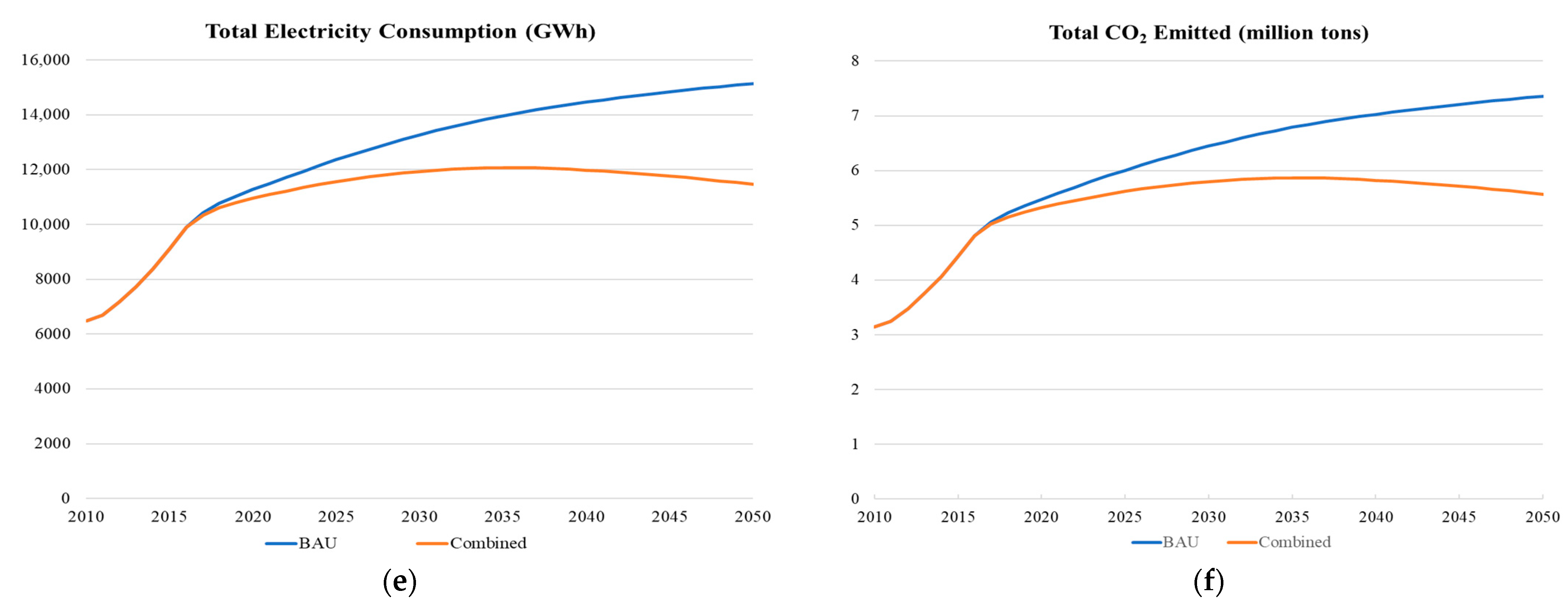
| Desalination and Water Treatment | Water Quality and Reuse | Groundwater Aquifer Recharge |
|---|---|---|
| Objective: Reduce desalination energy consumption and cost by 40% | Objective: Increase water quality and reuse by 30% | Objective: Elevate groundwater table to 1980 levels |
| Strategies | ||
|
|
|
| Water Storage Type | No. of Storage | Total Installed Capacity (m3) | Operating Capacity (m3) | Percentage of Total Storage (Operating) | |
|---|---|---|---|---|---|
| Reservoirs | Independent Water and Power Plant (IWPP) Reservoirs | 10 | 2,283,182 | 2,283,182 | 34.12% |
| KAHRAMAA Reservoirs | 28 | 4,390,909 | 4,390,909 | 65.62% | |
| Ground Tanks | 7 | 25,800 | 12,164 | 0.18% | |
| Elevated Tanks | 8 | 2986 | 900 | 0.01% | |
| Water Towers | 15 | 27,636 | 4500 | 0.07% | |
| Sector | Equation | Adjust R2 | F-Statistic, p-Value (α < 0.05) |
|---|---|---|---|
| Agriculture | 0.7908 | 13.6, 0.002632 | |
| Household | 0.9507 | 65.22, 1.759 × 10−5 | |
| Government | 0.7282 | 9.932, 0.006451 | |
| Commercial | 0.7077 | 9.071, 0.008269 | |
| Industry | 0.6026 | 6.054, 0.0234 |
| Equation | Description |
|---|---|
| |
| |
| |
| |
| |
| Emission factor for estimating CO2 produced from natural gas used in electricity generation: 486 gCO2/kWh | |
Publisher’s Note: MDPI stays neutral with regard to jurisdictional claims in published maps and institutional affiliations. |
© 2021 by the authors. Licensee MDPI, Basel, Switzerland. This article is an open access article distributed under the terms and conditions of the Creative Commons Attribution (CC BY) license (https://creativecommons.org/licenses/by/4.0/).
Share and Cite
Kamal, A.; Al-Ghamdi, S.G.; Koç, M. Assessing the Impact of Water Efficiency Policies on Qatar’s Electricity and Water Sectors. Energies 2021, 14, 4348. https://doi.org/10.3390/en14144348
Kamal A, Al-Ghamdi SG, Koç M. Assessing the Impact of Water Efficiency Policies on Qatar’s Electricity and Water Sectors. Energies. 2021; 14(14):4348. https://doi.org/10.3390/en14144348
Chicago/Turabian StyleKamal, Athar, Sami G. Al-Ghamdi, and Muammer Koç. 2021. "Assessing the Impact of Water Efficiency Policies on Qatar’s Electricity and Water Sectors" Energies 14, no. 14: 4348. https://doi.org/10.3390/en14144348
APA StyleKamal, A., Al-Ghamdi, S. G., & Koç, M. (2021). Assessing the Impact of Water Efficiency Policies on Qatar’s Electricity and Water Sectors. Energies, 14(14), 4348. https://doi.org/10.3390/en14144348







